Unique bivalves have traditional roles, commercial potential
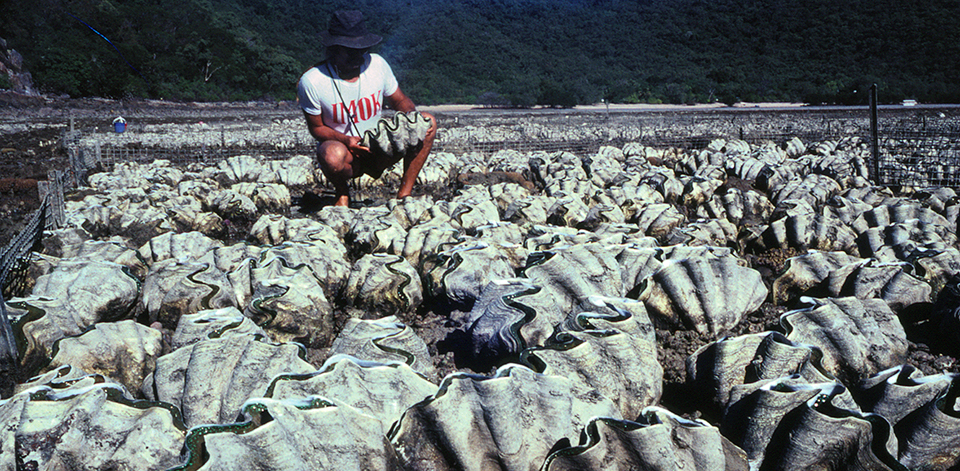
Giant clams (Tridacnidae) are unique bivalves, not only for their huge size, but also in having millions to billions of singled-celled symbiotic algae (called zooxanthellae) in their tissues. Their bodies are organized to expose a large area of mantle tissue packed with these algae to the light above. Photosynthesizing in light, the algae pass organic products to the clams. In return, the clams provide the algae with metabolic wastes to be used in photosynthesis. Giant clams also obtain some nutrition by filter feeding with their gills.
The need for strong light limits the depths where giant clams occur. Most are found from lower intertidal depths to about 15 meters.
Giant clam biology
There are nine species of giant clams. While five species reach 50-cm shell lengths, Tridacna gigas is the truly giant species. The largest bivalve that has ever lived, it has recorded shell lengths up to 1.3 meters, 500-kg weights and more than 60 years of age.
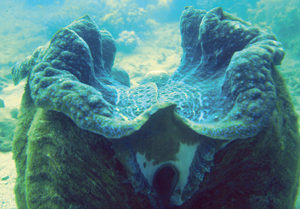
Like all giant clams, T. gigas is a hermaphrodite – each clam sheds sperm and eggs as separate events during spawning. All giant clam species are fecund, but large T. gigas release hundreds of millions of eggs in a spawning. The life cycle is typical of bivalves: planktonic larval development, settlement and metamorphosis, and progressive development to reach maturity and continued growth. The distinctive feature of this development is establishing symbiotic algae at the time of metamorphosis. Even tiny clams require sunlight.
Overfishing
By the 1980s, most giant clam species were heavily overfished in much of their Indo-Pacific coral reef regions, and there were regional extinctions. Overfishing for meat occurred due to local and international demand.
Pacific and some southeast Asian people eat clam meat as a subsistence food and sell it in local markets. In some countries, such as Taiwan, the clams’ large shell-closing adductor muscles are highly regarded, sometimes as an aphrodisiac. There was heavy international poaching in the 1970s and ’80s for this market.
Giant clams are also extensively fished in some regions to supply international markets for whole shells and shell craft. Local uses of the shells include their application in the manufacture of tiles and cement.
Clam mariculture was seen as a necessity and an opportunity. It was a way to supply market and subsistence demands for clam products, taking the pressure off wild stocks and providing clams for restocking the decimated populations.
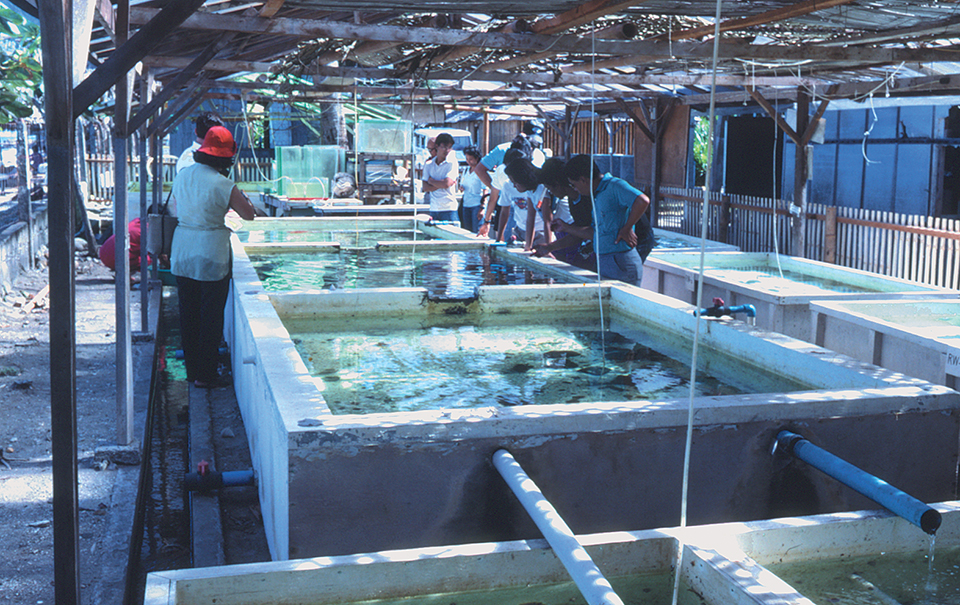
Mariculture
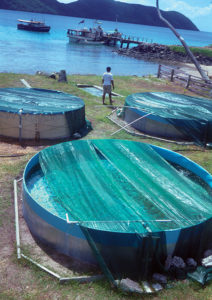
Giant clams are not difficult to culture and do not require expensive facilities. There are a number of comprehensive manuals for their culture.
The clams have relatively brief larval development, and then the juveniles are kept outdoors in sun-lit tanks with flow-through seawater. The clams can be kept for several years in tanks until supplied to the aquarium trade at a small size. Alternatively, juveniles can be kept for five months or so in tanks until reaching a size at which they can be put out into the field within protective meshes.
Several years later, they reach a size where predators are no longer a problem. Protective meshes are removed and little maintenance is required. The clams rest on the substrate and grow to an appropriate size for harvest. This final grow-out phase is rather akin to forestry. There are no adverse environmental effects from giant clam mariculture.
The techniques for ocean culture are appropriate for use by coastal communities, and programs have supplied hatchery-reared juveniles and technical training to villagers. A program involving 50 community farms was developed in the Solomon Islands by the WorldFish Center (then ICLARM). This program was disrupted by ethnic unrest.
Products and economics
Clem Tisdell and colleagues have reported the potential markets and economics of giant clam mariculture. Whole meat, adductor muscles, sushi and sashimi meat, shells, aquarium specimens, and hatchery seed are the marketable products generated from giant clams.
Adductor muscles, general meat and shells are harvested from large clams. Tisdell’s analyses showed optimum harvest times for the largest species (T. derasa and T. gigas) grown for these products of over 6.5 years, depending on the farm gate prices for each of the products.
Whole meat: There are local markets for whole clams in the Pacific islands and dried meat in countries such as Indonesia. Where Pacific islanders have emigrated, they provide a market for chilled or frozen giant clam meat.
Adductor muscle meat: Adductor muscle meat is a valuable product with ready markets for Chinese cuisine. Adductor muscles, however, represent about 12 percent or less of overall clam meat weight.
Sushi and sashimi: Sushi and sashimi markets for giant clam meat exist in Japan, especially Okinawa. For these products, smaller clams are required compared to whole meat and adductor markets. The sushi and sashimi markets require very fresh meat or live animals, up to 300 tons of “in the shell” clams.
Shells: Giant clam shells are still collected in traditional areas such as the Philippines. There is international trade in shells from wild clams, despite Convention on International Trade in Endangered Species of Wild Fauna and Flora listings of all species.
The value of giant clam shells depends on species and size. A pair of T. gigas shells of a size reached in culture can fetch over U.S. $400. Although growing periods are substantial for this market, the returns are high and there are no technical problems in shipping the product.
Aquarium trade: Aquaculture of giant clams for the aquarium trade is the major industry. North American retail prices range from about U.S. $30 to more than $220 per clam. Small specimens of the smallest and most brightly colored species, T. crocea and T. maxima, are most available. Most expensive and least available are Hippopus species and large T. derasa and T. gigas specimens greater than 15 cm in length.
Current status
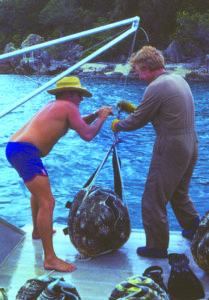
The relative ease of culture and inexpensive facilities required for giant clams, combined with the need to restock depleted reefs, and supply local consumption and the established aquarium market, have resulted in interest in giant clam mariculture in Pacific island nations and some southeast Asian nations. Most of this mariculture – conducted by government bodies, tertiary institutions, aid agencies, and small companies – is still on a small or pilot stage scale.
Pacific nations with giant clam mariculture programs are American Samoa, Cook Islands, Fiji, Kosrae, Malaysia, Palau, the Philippines, Pohnpei, Republic of the Marshall Islands, Samoa, Solomon Islands, and Tonga. There are also mariculture operations in the Cocos Islands and Red Sea. In addition, interest in giant clam mariculture can be found in French Polynesia, Indonesia, New Caledonia, and Vanuatu.
Restocking reefs is a major function of this mariculture, and there have been some reintroductions of extinct species from overseas hatcheries. Some clams are cultured for local consumption. The small companies are directed at the aquarium trade, and there is consideration of the sashimi market.
The Philippines has been most successful in restocking programs through the University of the Philippines Marine Science Institute (UPMSI) and Silliman University Marine Laboratory (SUML). T. gigas have been stocked on reefs throughout “the length and breath of the (Philippine) archipelago,” to quote Ed Gomez.
UPMSI has 10,000 T. gigas broodstock, progeny from imported and quarantined seed clams from Australia and the Solomons, and 500,000 T. squamosal juveniles. The institute is selling cultured clams to coastal industries that have an “environmental debt” to pay. SUML is selling clams to local government and nongovernment agencies for restocking in their sanctuaries.
The main commercial production of giant clams is for the tropical aquarium trade in North America, Europe and possibly Japan. There are strong indications of undersupply, with an apparent limited number of retailers.
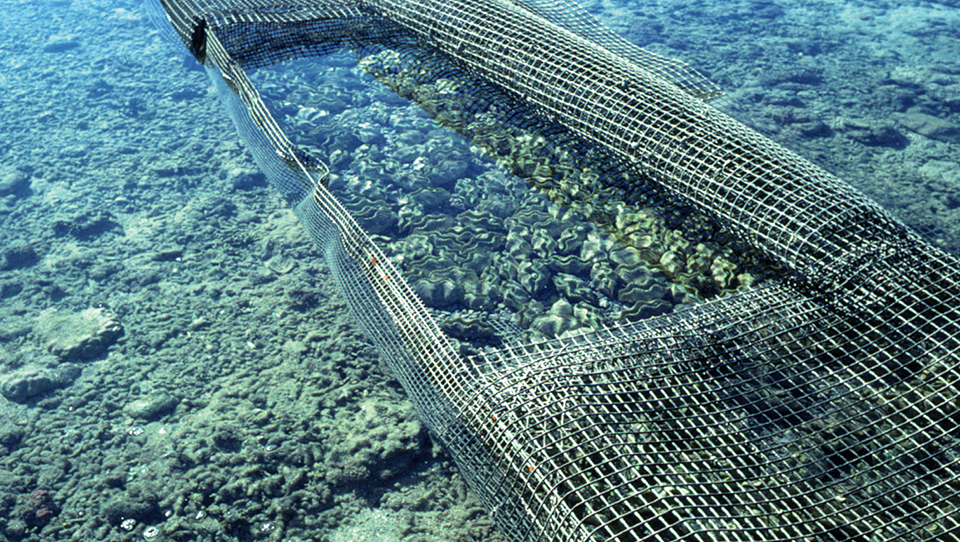
Conclusion
Giant clams are not difficult to culture, and a number of hatcheries and grow-out operations have been established in the Indo-Pacific region. For some of these nations, clam culture represents early moves into mariculture.
Most clam mariculture is for restocking depleted reefs. The main commercial activity is through small companiesthat provide small clams for the aquarium trade. The advantage of this trade is that the high-value product takes only two years to reach marketable size. Other markets require products from larger, older clams. Mariculture of giant clams will continue on a small scale, but there are large markets for clam products that have yet to be tapped.
Major developments will probably see large entrepreneurial companies identify economic markets of an international scale. Since some high-value clam products require growth periods over six years, it is likely such companies would also target markets for 2- and 3-year-old clams. Selling seed clams to other operations could be another source of early financial returns.
Many products require rapid and reliable air links from farms to international markets, which will constrain the kind of giant clam mariculture practiced in some Indo-Pacific regions. One strategy may be to use several sites for progressive culture of the clams. Reintroductions have demonstrated that seed clams can be conveniently transported in large numbers over long distances.
(Editor’s Note: This article was originally published in the June 2003 print edition of the Global Aquaculture Advocate.)
Now that you've reached the end of the article ...
… please consider supporting GSA’s mission to advance responsible seafood practices through education, advocacy and third-party assurances. The Advocate aims to document the evolution of responsible seafood practices and share the expansive knowledge of our vast network of contributors.
By becoming a Global Seafood Alliance member, you’re ensuring that all of the pre-competitive work we do through member benefits, resources and events can continue. Individual membership costs just $50 a year.
Not a GSA member? Join us.
Author
-
John Lucas, Ph.D.
Centre for Marine Studies
University of Queensland
St. Lucia, Queensland, 4072 Australia[117,97,46,117,100,101,46,113,117,46,101,110,105,114,97,109,64,115,97,99,117,108,46,106]
Tagged With
Related Posts
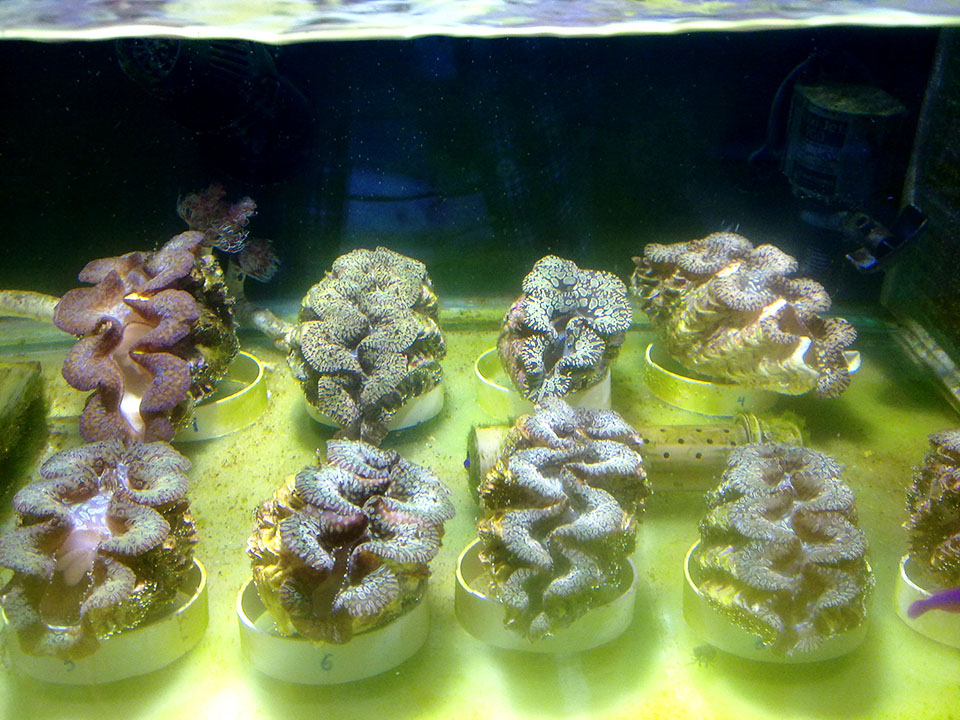
Health & Welfare
Limitations facing giant clam aquaculture
Giant clams are a resource utilized by the food and aquarium trade markets. However, aquaculture production is low and does not supply the demand. Ready availability of broodstock and seed is a major problem, as well as practical and consistent methods for inducing spawning.
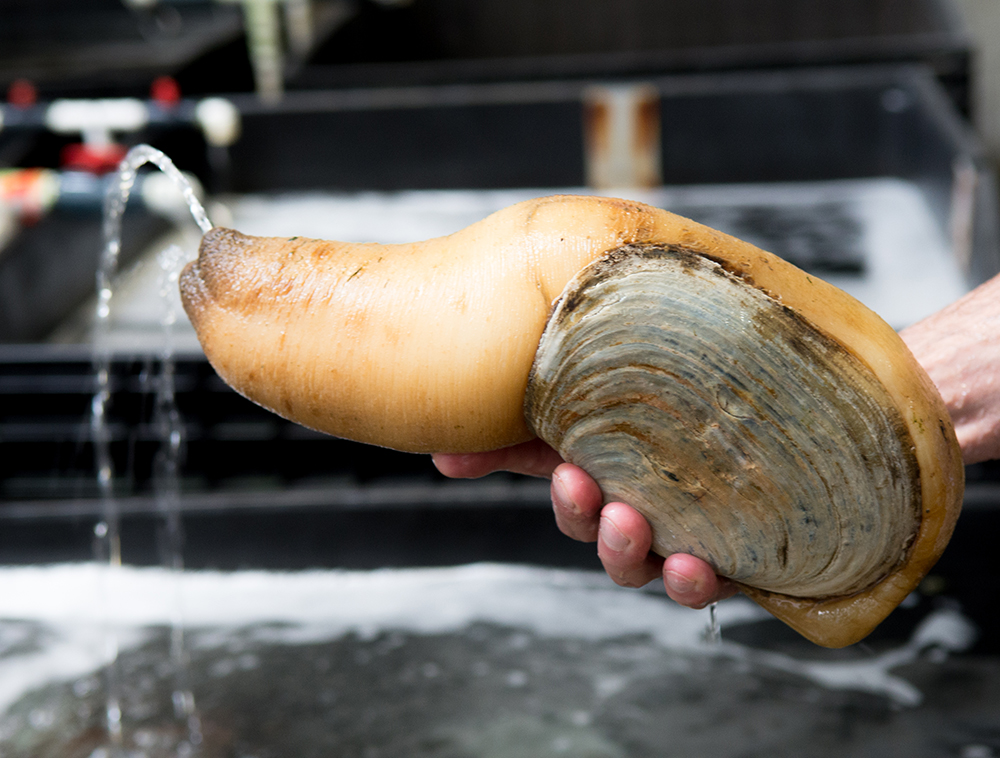
Intelligence
Despite Seafood Watch downgrade, few market changes for geoducks
A rating change for Pacific geoducks farmed in Washington state and British Columbia surprised and confused many in the field, since it’s a segment of the industry generally considered sensitive to sustainability issues.
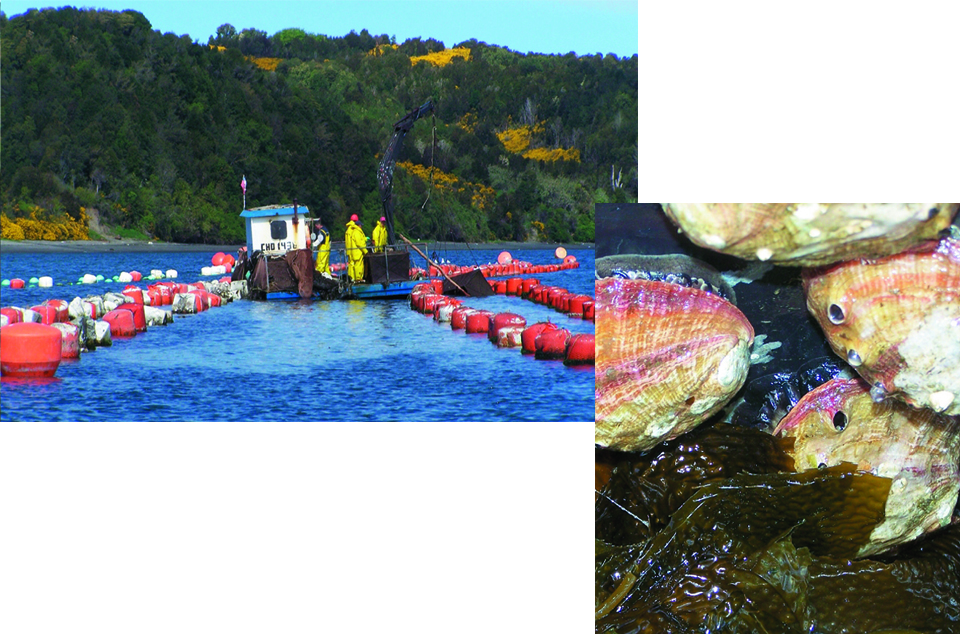
Intelligence
Mussels, scallops lead Chile’s mollusk industry
For most mollusk resources, spat supply is not stable enough to sustain the growing industry. Competition for coastline space must also be considered.
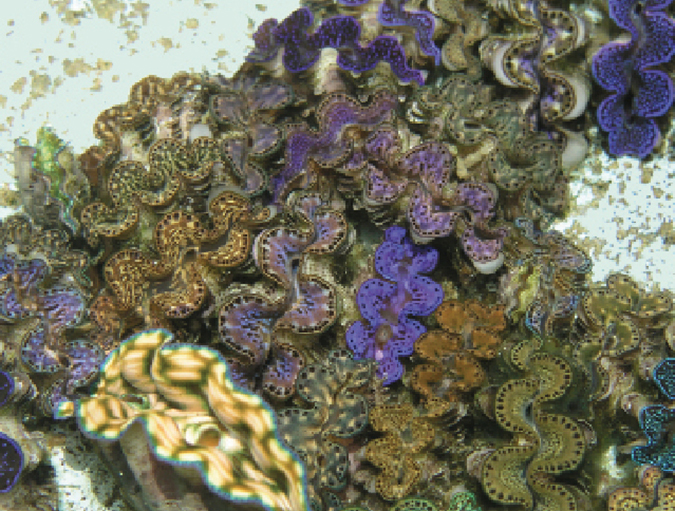
Responsibility
Pacific Islands communities support aquaculture development
Threats from overfishing and climate change highlight the need for alternative methods of local seafood production and economic advancement throughout the Pacific Islands. Ongoing work with giant clams, pearl oysters and crabs helps meet consumer needs and replenish stocks.


